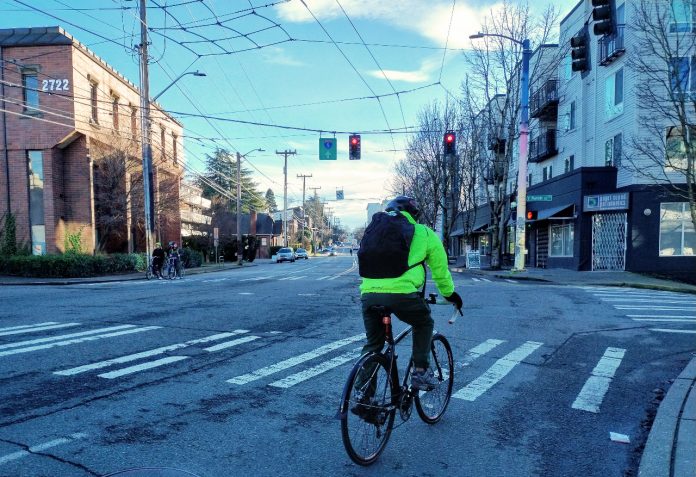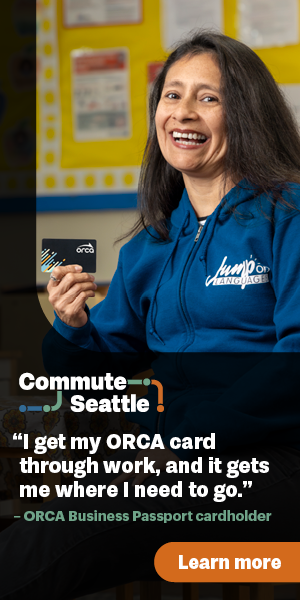
This week a broad coalition of transportation advocates sent a letter urging the City of Seattle to pursue a larger transportation levy package than currently under consideration in order to meet its own affirmed goals on climate, safety, equity, and qualify of life. The coalition estimated the price tag at $3 billion to get Seattle on course to meeting those goals, many of which have been laid out in the Seattle Transportation Plan.
Move Seattle, the nine-year transportation levy approved in 2015 and set to expire at year’s end, was a $930 million package. However, with the City falling behind on key climate goals and actually going backward recently on its pledge to end traffic deaths by 2030, the coalition argues now is the time to accelerate investment rather than coast.
The coalition includes Disability Rights Washington, Seattle Neighborhood Greenways, Cascade Bicycle Club, Seattle Subway, Transit Riders Union, 350 Seattle, House Our Neighbors, Real Change, Puget Sound Sage, and The Urbanist.
“To put the city on track to meeting its mobility, safety, equity, maintenance, and sustainability goals,” the advocates wrote, “Seattle must invest just over $3 billion over the next 8 years in building:
- Safety redesigns on Seattle’s five deadliest streets to prevent fatal and serious injury crashes.
- 331 miles of new sidewalks to fill in gaps in the network.
- 60 new linear miles of dedicated transit corridors to cut commute times by 20% or more on key bus routes.
- 154 miles of new safe bike lanes and 73 miles of upgraded protection on existing bike lanes to advance our citywide bike network.
- 750 intersections with upgraded safety treatments and 320 accessible pedestrian signals.
- And more. See the full document here.“
Tripling the size of the levy may be seen as a dramatic step, but it is one the Harrell administration just took when renewing the Seattle Housing Levy in 2023. Voters supported that decision to the tune of a landslide 69% victory. The City justified the larger package by stressing both the great need for affordable housing and the fact that a period of high inflation was cutting into spending power on housing investments, with construction inflation particularly high. The larger levy helped to counteract that trend to still deliver more housing.
Underdelivering on the last round of transportation promises was an issue. The Move Seattle Levy has come up short on several key campaign promises, including the pledge to upgrade seven bus routes to enhanced RapidRide lines with some bus rapid transit features. So far, only the RapidRide H Line (upgrading Route 120) has been delivered, with the G Line on Madison Street expected in fall 2024 and the J Line (upgrading Route 70 in abbreviated form) still in progress and expected in 2027. However, RapidRide upgrades promises for Route 7, 40, 44, and 48 were ultimately jettisoned and replaced by lesser improvements.
The Seattle Department of Transportation (SDOT) is scrambling in the final year of Move Seattle to try to get closer to initial pledges of 110 miles of new bike infrastructure after a series of delays and a few project cancelations curtailed progress. Safety projects for high crash corridors also mostly failed to deliver on the hype.
“Similarly, SDOT set a goal of completing 12 to 15 ‘safety corridors’ across the city, and the chart shows the department set to clear that goal with room to spare,” The Urbanist‘s Ryan Packer wrote last year. “But MLK Jr Way S, Airport Way S, or Aurora Avenue N, all called out by name in 2015, didn’t see any significant safety upgrades. If you were voting for the levy in the hopes of seeing your dangerous and busy street nearby tamed and turned more walkable, a green box could be seen less as consolation and more as an insult.”
In addition to having more marquee projects to inspire voters, advocates said they are also pushing the City to have all its lofty long-term plans and visions to connect with the new levy investment plan that will animate those visions and aspirational values with actual dollars.
“The next transportation funding package, including the transportation levy, must realize the goals and visions of the Seattle Department of Transportation (SDOT)’s draft Seattle Transportation Plan (STP),” advocates wrote. “The attached report contains cost estimates based on numbers from Seattle Transportation Plan’s Draft Environmental Impact Statement (DEIS) “Alternative 3 for Rapid Progress” (as preferred by 95% of community surveyed). We used the city’s Climate Change Response Framework, Transportation Equity Framework, ADA Transition Plan, and Vision Zero plan to fill in missing gaps.”
But one issue with Move Seattle was that its initial workplan assumed a quick ramp-up to utilize the additional funding starting in 2016, but in reality SDOT experienced significant issues staffing up to be able to deliver what it promised voters. The department now says it’s in a much better place than 2016-2019 when it comes to project delivery and staff capacity, and the department has made considerable strides in streamlining the public input process, formerly a big source of project delay. But promising too much could be setting the city up for a repeat performance.
The other big obstacle for Move Seattle was federal grants drying up for transit projects once the Trump administration took over in 2017. This too could be an obstacle again.
SDOT recently commissioned a poll of Seattle voters that tested two levy options: one at $1.2 billion that only keeps up with inflation and another $1.7 billion that would provide more new investments. Voters supported both measure, but the incrementally higher support for the smaller package has led advocates to worry that the City will go with the easier package to pass rather than a package in line with needs.
“We also hope this report can be used by City Councilmembers, policymakers, advocates, and voters to assess the alignment between the Mayor’s forthcoming transportation funding proposal and the needed projects that reflect our city’s adopted values, plans and priorities,” the advocates wrote.
Mayor Bruce Harrell is expected to unveil his proposal for the levy package this spring, and it should go to the city council for approval by the summer so that it can appear on November ballots.
Seattle Subway has set up an Action Network for supporters to email City officials urging them to supporter the broader vision for the levy.
Doug Trumm is publisher of The Urbanist. An Urbanist writer since 2015, he dreams of pedestrian streets, bus lanes, and a mass-timber building spree to end our housing crisis. He graduated from the Evans School of Public Policy and Governance at the University of Washington in 2019. He lives in Seattle's Fremont neighborhood and loves to explore the city by foot and by bike.




